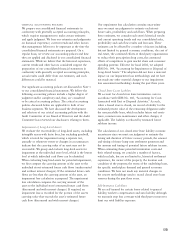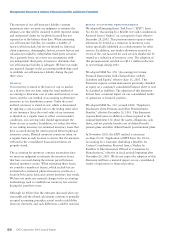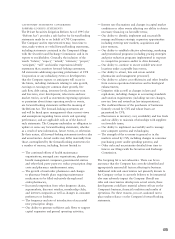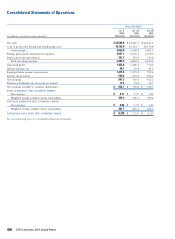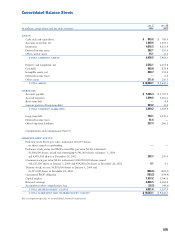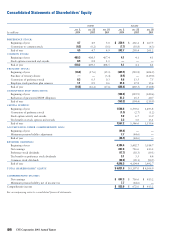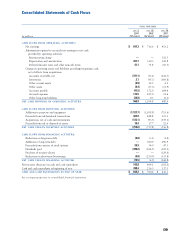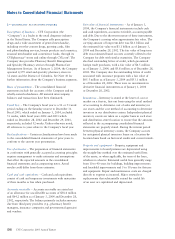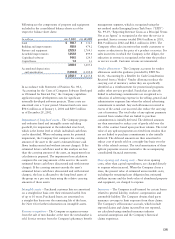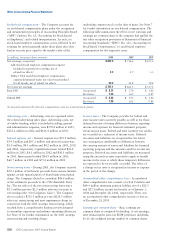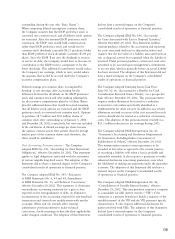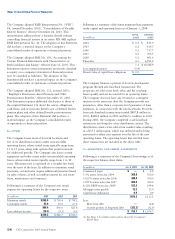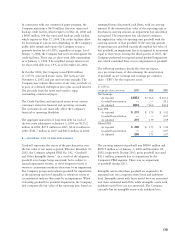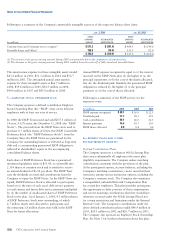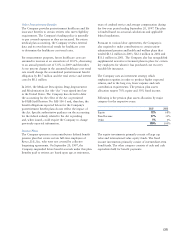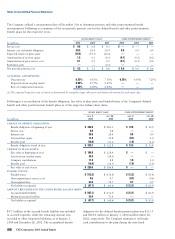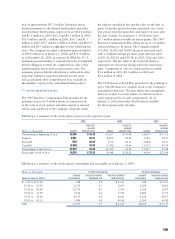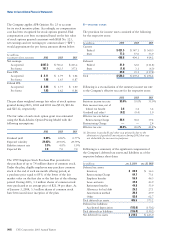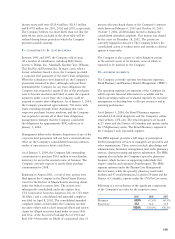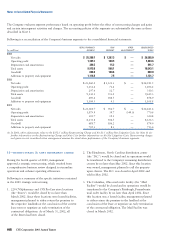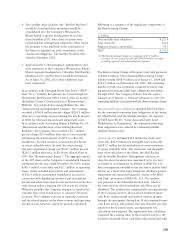CVS 2003 Annual Report Download - page 35
Download and view the complete annual report
Please find page 35 of the 2003 CVS annual report below. You can navigate through the pages in the report by either clicking on the pages listed below, or by using the keyword search tool below to find specific information within the annual report.outstanding during the year (the “Basic Shares”).
When computing diluted earnings per common share,
the Company assumes that the ESOP preference stock is
converted into common stock and all dilutive stock options
are exercised. After the assumed ESOP preference stock
conversion, the ESOP trust would hold common stock
rather than ESOP preference stock and would receive
common stock dividends (currently $0.23 per share) rather
than ESOP preference stock dividends (currently $3.90 per
share). Since the ESOP Trust uses the dividends it receives
to service its debt, the Company would have to increase its
contribution to the ESOP trust to compensate it for the
lower dividends. This additional contribution would reduce
the Company’s net earnings, which in turn, would reduce
the amounts that would be accrued under the Company’s
incentive compensation plans.
Diluted earnings per common share is computed by
dividing: (i) net earnings, after accounting for the
difference between the dividends on the ESOP preference
stock and common stock and after making adjustments
for the incentive compensation plans by (ii) Basic Shares
plus the additional shares that would be issued assuming
that all dilutive stock options are exercised and the ESOP
preference stock is converted into common stock. Options
to purchase 18.5 million and 20.0 million shares of
common stock were outstanding as of January 3, 2004
and December 28, 2002, respectively, but were not included
in the calculation of diluted earnings per share because
the options’ exercise prices were greater than the average
market price of the common shares and, therefore, the
effect would be antidilutive.
New Accounting Pronouncements ~ The Company
adopted SFAS No. 143, “Accounting for Asset Retirement
Obligations,” effective December 29, 2002. This statement
applies to legal obligations associated with the retirement
of certain tangible long-lived assets. The adoption of this
Statement did not have a material impact on the Company’s
consolidated results of operations or financial position.
The Company adopted SFAS No. 145, “Rescission
of FASB Statements No. 4, 44 and 64, Amendment
of FASB Statement No. 13, and Technical Corrections,”
effective December 29, 2002. This statement (i) eliminates
extraordinary accounting treatment for a gain or loss
reported on the extinguishment of debt, (ii) eliminates
inconsistencies in the accounting required for sale-leaseback
transactions and certain lease modifications with similar
economic effects and (iii) amends other existing
authoritative pronouncements to make technical
corrections, clarify meanings or describe their applicability
under changed conditions. The adoption of this Statement
did not have a material impact on the Company’s
consolidated results of operations or financial position.
The Company adopted SFAS No. 146, “Accounting
for Costs Associated with Exit or Disposal Activities,”
effective December 29, 2002. This Statement nullifies
existing guidance related to the accounting and reporting
for costs associated with exit or disposal activities and
requires that the fair value of a liability associated with an
exit or disposal activity be recognized when the liability is
incurred. Under previous guidance, certain exit costs were
permitted to be accrued upon management’s commitment
to an exit plan, which is generally before an actual liability
has been incurred. The adoption of this Statement did not
have a material impact on the Company’s consolidated
results of operations or financial position.
The Company adopted Emerging Issues Task Force
Issue No. 02-16, “Accounting by a Reseller for Cash
Consideration Received from a Vendor,” on a prospective
basis effective December 29, 2002. This pronouncement
requires vendor allowances be treated as a reduction
in inventory costs unless specifically identified as a
reimbursement for other services. In addition, any vendor
allowances received in excess of the cost incurred for such
services should also be treated as a reduction of inventory
costs. The adoption of this pronouncement resulted in a
$13.3 million reduction in net earnings during 2003.
The Company adopted FASB Interpretation No. 45,
“Guarantor’s Accounting and Disclosure Requirements
for Guarantees, Including Indirect Guarantees of
Indebtedness of Others,” effective December 29, 2002.
This interpretation requires certain guarantees to be
recorded at fair value as opposed to the current practice
of recording a liability only when a loss is probable and
reasonably estimable. It also requires a guarantor to make
enhanced disclosures concerning guarantees, even when
the likelihood of making any payments under the guarantee
is remote. The adoption of this Statement did not have a
material impact on the Company’s consolidated results
of operations or financial position.
The Company adopted FASB Interpretation No. 46,
“Consolidation of Variable Interest Entities,” effective
December 29, 2002. This interpretation requires a company
to consolidate variable interest entities (“VIE”) if the
enterprise is a primary beneficiary (holds a majority of the
variable interest) of the VIE and the VIE possesses specific
characteristics. It also requires additional disclosures for
parties involved with VIEs. The adoption of this Statement
did not have a material impact on the Company’s
consolidated results of operations or financial position.
(33)


